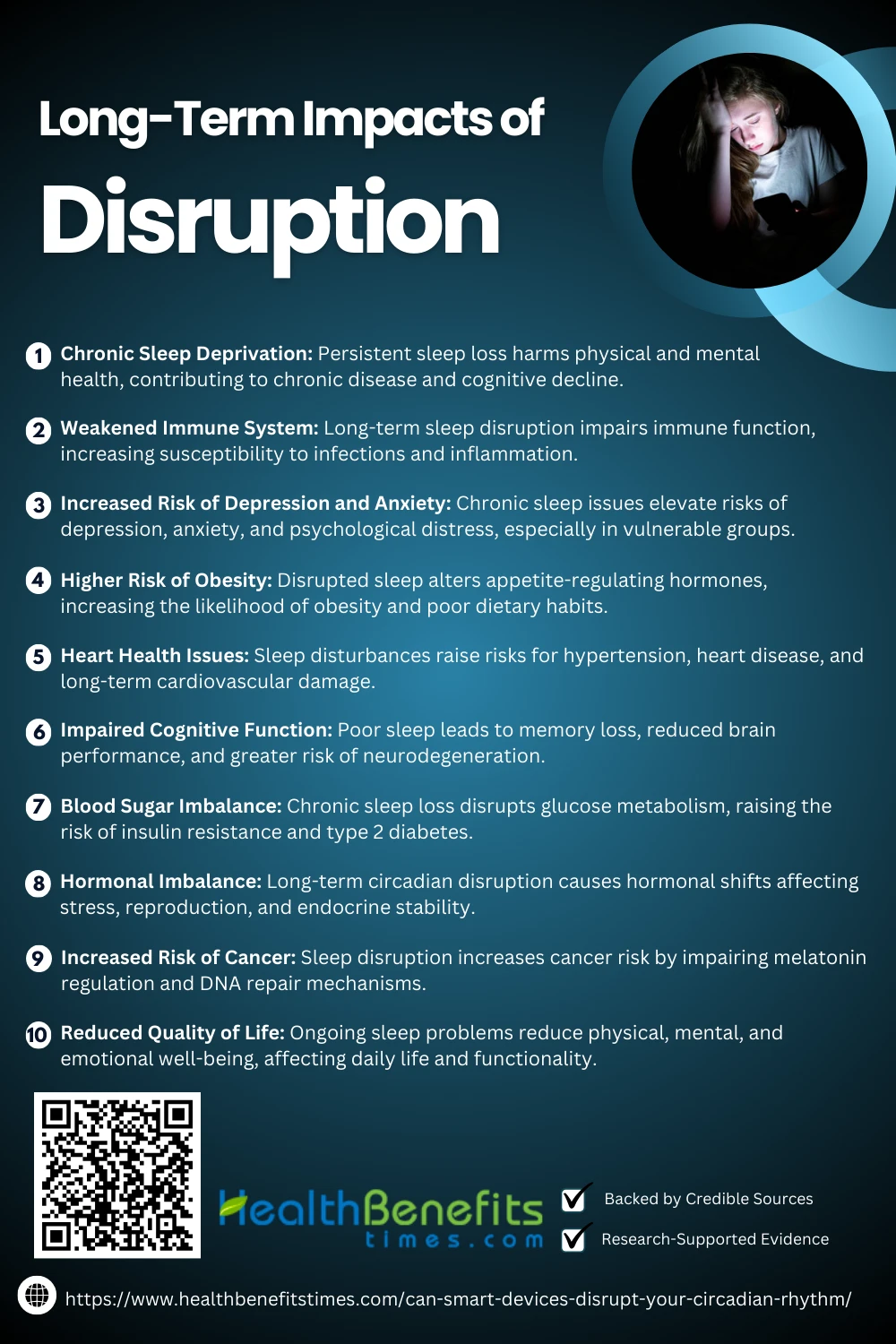- Smart devices are internet-connected electronic gadgets that collect, process, and exchange data to assist users in daily tasks.
- Excessive use of smart devices—especially before bedtime—can interfere with melatonin production and disrupt natural sleep-wake cycles.
- This article explores how screen exposure and device habits may negatively impact circadian rhythm and overall sleep health.
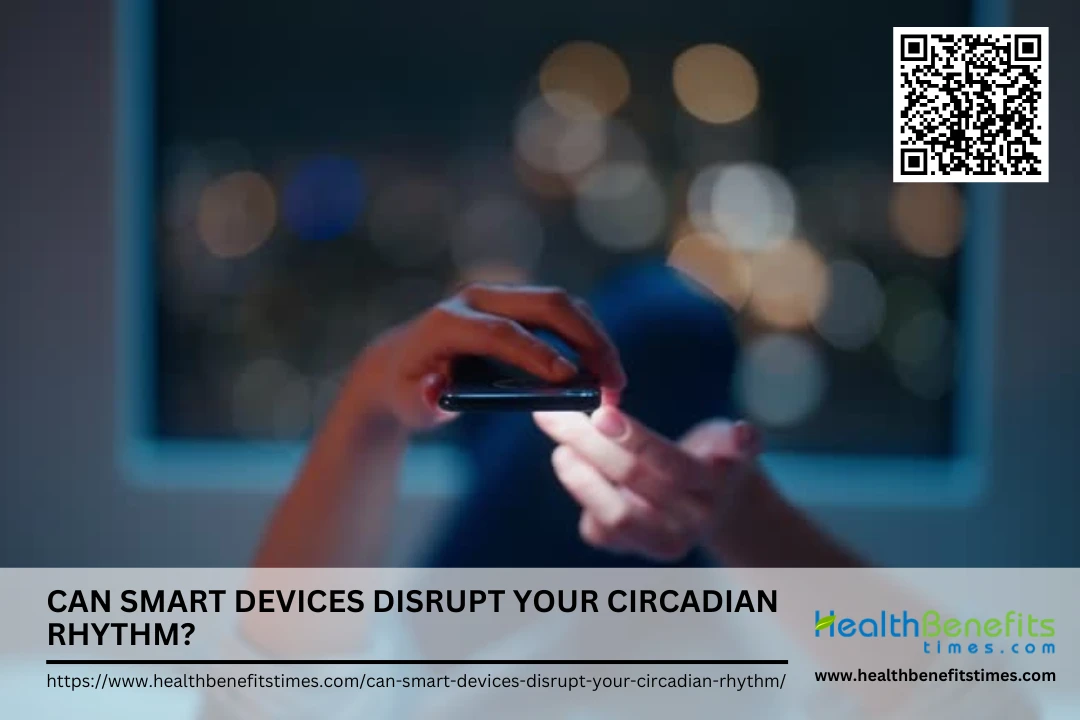 Smart devices refer to electronic gadgets such as smartphones, tablets, smartwatches, and other connected digital tools that can interact with users and other devices through wireless protocols like Wi-Fi and Bluetooth, often offering real-time functionalities like notifications, health tracking, and media access. In our modern age of digital connectivity, smart devices have become nearly inseparable from daily life—used for communication, productivity, and entertainment. However, their widespread use, especially in the evening hours, has raised critical concerns about their potential impact on the body’s internal biological clock, known as the circadian rhythm. The core issue stems from short-wavelength blue light emitted by device screens, which research has shown can suppress melatonin secretion—a hormone that regulates sleep-wake cycles—and delay sleep onset. Furthermore, recent studies emphasize that evening screen exposure not only affects sleep duration and quality but may also lead to long-term circadian misalignment, contributing to a range of health risks such as insomnia, metabolic disorders, and mood disturbances. As digital habits evolve, it becomes increasingly important to understand the biological implications of smart device use—especially as we bring these devices into our bedrooms and nighttime routines.
Smart devices refer to electronic gadgets such as smartphones, tablets, smartwatches, and other connected digital tools that can interact with users and other devices through wireless protocols like Wi-Fi and Bluetooth, often offering real-time functionalities like notifications, health tracking, and media access. In our modern age of digital connectivity, smart devices have become nearly inseparable from daily life—used for communication, productivity, and entertainment. However, their widespread use, especially in the evening hours, has raised critical concerns about their potential impact on the body’s internal biological clock, known as the circadian rhythm. The core issue stems from short-wavelength blue light emitted by device screens, which research has shown can suppress melatonin secretion—a hormone that regulates sleep-wake cycles—and delay sleep onset. Furthermore, recent studies emphasize that evening screen exposure not only affects sleep duration and quality but may also lead to long-term circadian misalignment, contributing to a range of health risks such as insomnia, metabolic disorders, and mood disturbances. As digital habits evolve, it becomes increasingly important to understand the biological implications of smart device use—especially as we bring these devices into our bedrooms and nighttime routines.
Understanding the Circadian Rhythm
The circadian rhythm is an internal biological clock that operates on a roughly 24-hour cycle, regulating various physiological processes, including sleep-wake patterns, hormone secretion, and metabolism. This rhythm is primarily governed by the suprachiasmatic nucleus (SCN) in the brain’s hypothalamus, which synchronizes bodily functions with environmental cues like light and darkness. (1)
Circadian rhythms play a critical role in regulating sleep cycles, body temperature, and hormonal release. The rhythm ensures peak alertness during the day and induces sleepiness at night, partly by lowering core body temperature in preparation for sleep. (2) It also controls hormones like cortisol (which boosts alertness in the morning) and melatonin (which promotes sleep at night). (3)
Natural cues, particularly light and darkness, are fundamental to circadian synchronization. Light exposure in the morning resets the biological clock, while darkness at night triggers melatonin release. (4) Disruption of this light-dark cycle, such as exposure to artificial light at night, can significantly affect sleep quality and circadian alignment. (5)
Melatonin, often termed the “sleep hormone,” is secreted by the pineal gland in response to darkness. It acts as a signal to the body that it’s time to rest. Studies show that elevated nighttime melatonin correlates with reduced core body temperature and improved sleep onset, reinforcing its crucial role in maintaining circadian stability. (6) (7)
How Smart Devices Affect the Circadian Rhythm
Smart devices emit blue light and stimulate the brain, which can disrupt your body’s natural sleep-wake cycle, known as the circadian rhythm, making it harder to fall and stay asleep.
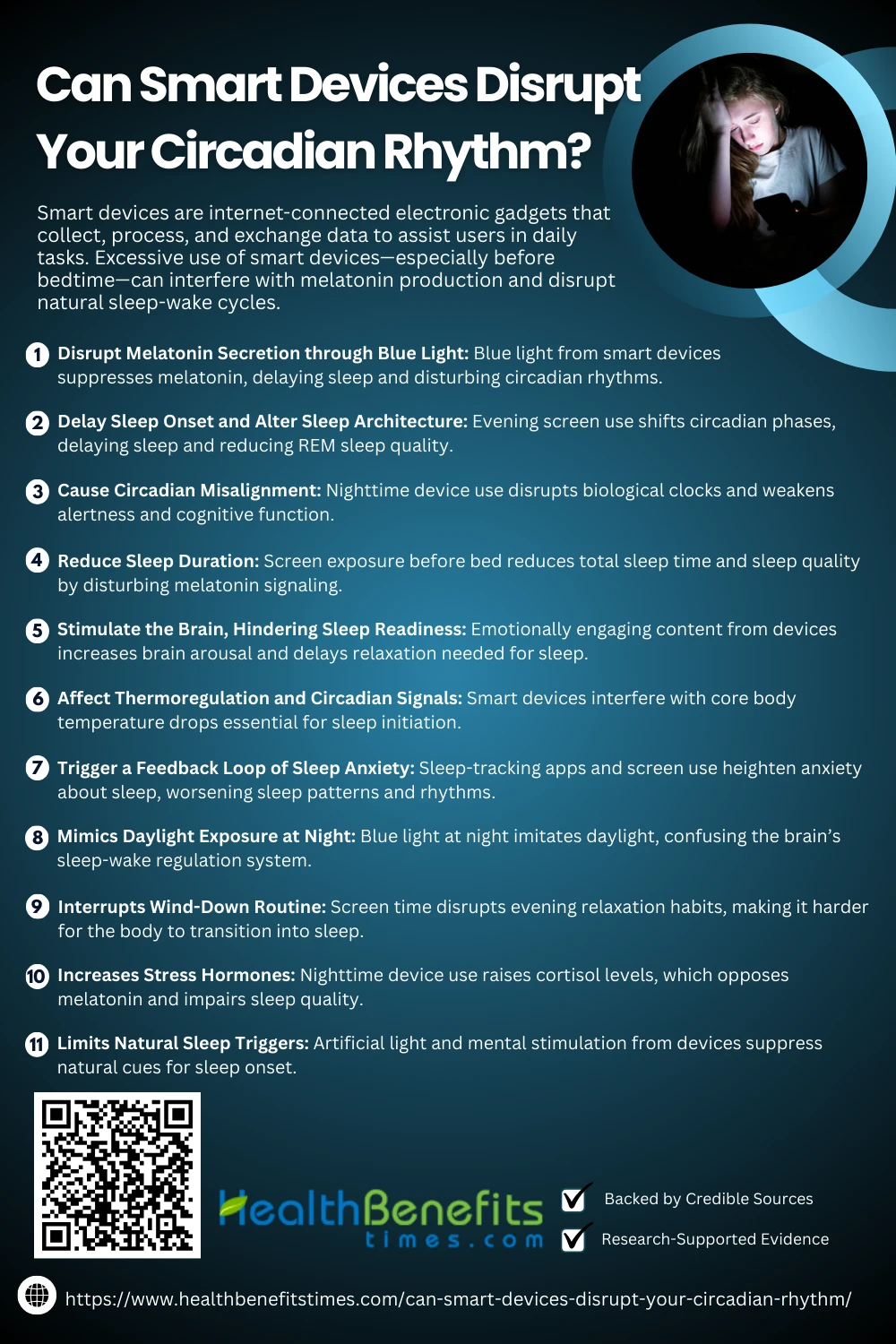 1. Disrupt Melatonin Secretion through Blue Light
1. Disrupt Melatonin Secretion through Blue Light
Smart devices emit blue light that suppresses melatonin, a hormone essential for initiating sleep. This short-wavelength light delays the body’s natural signal to wind down, disrupting circadian alignment. (8) Repeated exposure from phones and tablets alters hormonal cycles, especially at night. (7) Studies show reduced melatonin secretion due to screens, impairing sleep onset and duration and destabilizing internal clocks. (9) (10) (11)
2. Delay Sleep Onset and Alter Sleep Architecture
Evening smart device use delays sleep onset and disrupts sleep architecture by shifting circadian phases. (6) These devices stimulate the brain and prevent the natural sleep transition. (12) Prolonged use has been linked to reduced REM sleep and altered melatonin profiles, even under dim light. (13) (10) As a result, users experience delayed circadian timing and poor sleep quality. (14)
3. Cause Circadian Misalignment
Smart devices can cause circadian misalignment by delaying the natural biological clock and altering sleep-wake cues. Blue light exposure at night shifts melatonin production and disrupts phase timing. This misalignment may impair alertness and cognition, elevate disease risks, and fragment core circadian functions. (9) (8) (15)
4. Reduce Sleep Duration
Smart device usage before bedtime has been directly associated with reduced total sleep duration and delayed sleep onset, weakening circadian rhythm stability. Light from screens disrupts melatonin signaling (Elmenhorst et al., 2025) and promotes sleep curtailment across age groups. (13) This disruption can increase sleep fragmentation, impair memory consolidation, and degrade sleep efficiency. (7) (10) (6)
5. Stimulate the Brain, Hindering Sleep Readiness
Smart devices heighten cognitive arousal through emotionally engaging content, delaying sleep readiness. Notifications, games, and social media stimulate the prefrontal cortex, impeding melatonin onset and relaxing brain states (Wörle et al., 2020). Emotional stimulation before sleep increases physiological alertness and reduces deep sleep. (7) (16) This overstimulation weakens circadian rhythm cues and prolongs sleep latency. (17) (18)
6. Affect Thermoregulation and Circadian Signals
Evening smart device use disrupts thermoregulation, a core circadian signal. Exposure to blue light inhibits melatonin and prevents the natural drop in core body temperature, delaying sleep onset. (19) The screen light can flatten circadian temperature cycles, impairing body-clock alignment. (20) These effects are compounded by cognitive stimulation from screen use and affect both sleep depth and timing. (21) (22) (23)
7. Trigger a Feedback Loop of Sleep Anxiety
Smart devices foster sleep anxiety, especially among users who monitor their sleep obsessively with apps and wearables. This condition—called orthosomnia—arises from striving for “perfect sleep,” ironically making rest more elusive. These anxious behaviors disrupt circadian stability and prolong wakefulness. Blue light from screens worsens this effect by inhibiting melatonin release. (7)
8. Mimics Daylight Exposure at Night
The blue light emitted by smart devices at night mimics daylight, confusing the brain’s internal clock and leading to circadian misalignment. This artificial photic signal delays melatonin onset and disrupts sleep timing. (24) Even dim light at night can phase-shift circadian rhythms. (7) Continuous night exposure to screens alters sleep quality, body temperature, and the master clock in the SCN. (25) (22) (19)
9. Interrupts Wind-Down Routine
Smart devices interfere with bedtime wind-down routines, delaying the body’s natural shift into rest. Their cognitive and sensory stimulation hampers melatonin onset and disrupts circadian readiness for sleep. (7) Students using phones before bed showed reduced sleep quality and rhythm stability. Digital pre-sleep habits alter emotional states and hinder consistent sleep cues. (26)
10. Increases Stress Hormones
Using smart devices at night elevates cortisol levels, a key stress hormone, which counters melatonin’s sleep-promoting effects. Bright screens activate the hypothalamic-pituitary-adrenal (HPA) axis, increasing arousal and delaying circadian timing. (22) Cortisol surges before sleep impair slow-wave sleep and deepen circadian misalignment. (27) (28) (29) (30)
11. Limits Natural Sleep Triggers
Smart devices suppress natural sleep triggers like darkness and mental stillness by emitting artificial blue light that mimics daylight. This exposure reduces melatonin production and confuses the body’s biological night signals. (11) It delays sleep readiness by altering photoreceptor signaling, masks circadian light cues, and prevents natural melatonin onset. (7) (31) (32)
Long-Term Impacts of Disruption
Disrupting your circadian rhythm over time can lead to serious health issues. From sleep disorders to chronic diseases, the long-term effects impact your body, mood, and overall quality of life.
Chronic sleep deprivation significantly impairs physical and cognitive health, leading to cardiovascular disease, obesity, and reduced mental resilience. Research highlights its role in increased public healthcare burden, metabolic dysregulation, and long-term neurocognitive impairments. (33) (34) (35) Studies also link it to heightened insomnia-driven morbidity and chronic disease progression. (36) (37) Persistent sleep loss disrupts hormonal balance and immune response, underscoring the importance of sustainable sleep hygiene and preventive public health measures.
2. Weakened Immune System
Long-term sleep disruption weakens immune competence, increasing vulnerability to infections and chronic disease. Studies show disrupted circadian rhythms alter cytokine profiles and reduce immune efficacy. (38) Research in adolescents confirmed neuroimmune disturbances following sleep deprivation, while others identify links to systemic inflammation and mental health decline. (39) (40) Moreover, sleep-related immune impairments are documented in pediatric populations and shown to impact long-term cardiovascular health. (41) (42)
3. Increased Risk of Depression and Anxiety
Prolonged sleep disruption significantly raises the risk of developing depression and anxiety. Evidence suggests that chronic sleep loss contributes to elevated psychological distress, especially in conflict-affected zones. Young adults show marked increases in depressive symptoms linked to poor sleep hygiene. (43) The pandemic intensified mental health vulnerabilities, with further links to environmental trauma and neurochemical disruption. (33) (44) (45)
4. Higher Risk of Obesity
Sleep disruption contributes to hormonal imbalances and appetite dysregulation, fostering long-term obesity risks. In pediatric cases, sleep disorders are closely linked with increased obesity prevalence. (46) Sleep deprivation in young adults correlates with poor dietary choices and higher BMI trajectories. (43) Insufficient rest among truck drivers leads to metabolic health deterioration. (47) Screen exposure also amplifies adolescent sleep–obesity pathways, while nutritional reviews affirm sleep’s role in body weight regulation. (48) (49)
5. Heart Health Issues
Prolonged sleep disruption leads to elevated cardiovascular risks, including hypertension and heart disease. Systematic studies confirm the link between sleep disorders and heart damage, exacerbated by noise and circadian misalignment. (50) (51) Behavioral interventions have been suggested for shift workers. (52) The pandemic highlighted sleep-heart interdependence, while studies on metabolic strain reveal chronic risks in drivers, emphasizing the need for sleep regulation as a cardioprotective measure. (53) (47)
6. Impaired Cognitive Function
Disrupted sleep severely impairs cognition, leading to memory deficits and neurological decline. NASA findings link long-term sleep loss with behavioral and neural performance deficits. (54) Animal studies suggest associations with neurodegeneration and tauopathy. (55) In aging populations, sleep-related depression and cognitive impairment are prevalent. (56) Chronic disorders like Parkinson’s reflect sleep as a predictor of cognitive decline, while professional fatigue studies highlight its role in occupational mental decline. (57) (58)
7. Blood Sugar Imbalance
Chronic sleep disruption impairs glucose metabolism, heightening risks for insulin resistance and type 2 diabetes. Research reveals disrupted circadian rhythms hinder insulin sensitivity and promote metabolic disorders. (59) (60) High-fat diets coupled with poor sleep show increased blood sugar variability. Poor sleep elevates risks associated with fructose-induced glycemic imbalance and neuroinflammatory responses to glucose dysregulation (Pourasghari et al., 2024), highlighting the urgency for metabolic interventions. (60)
8. Hormonal Imbalance
Long-term sleep disturbances disrupt hormonal equilibrium, leading to elevated cortisol, impaired melatonin production, and altered reproductive function. Studies highlight how chronic sleep loss affects neuroendocrine rhythms, especially in adolescents. (50) (61) Reviews show melatonin misuse can cause endocrine instability, while mycotoxin exposure compounds hormonal dysregulation. (62) (45) Sleep disturbances also lead to long-term effects in reproductive health and fertility disruption. (42)
9. Increased Risk of Cancer
Long-term sleep disruption increases cancer susceptibility due to melatonin suppression and hormonal imbalances. Studies link night-shift work with elevated breast cancer risk, while circadian rhythm dysregulation impacts DNA repair. (63) (64) Disrupted sleep patterns in pediatric oncology survivors show prolonged oncologic vulnerability. (65) Glycemic and metabolic impacts further potentiate cancer pathways, including colorectal and prostate malignancies. (42) Light-at-night exposure also correlates with higher tumorigenic markers. (66)
10. Reduced Quality of Life
Chronic sleep disruption leads to reduced quality of life by impairing physical, emotional, and cognitive functioning. Post-trauma sleep deprivation intensifies neuroinflammation and distress, while Parkinson’s patients experience diminished daily well-being. (67) (57) Poor sleep is also linked to cognitive decline and depression. (56) Fibromyalgia and neurodegenerative patients report worsened symptoms and functional limitations. (68) Even glomerular disease sufferers show lower health-related quality of life, emphasizing sleep’s critical role in well-being. (69)
Wearable and Their Double-Edged Role
Wearables like smart watches and fitness trackers help monitor health and improve sleep, but constant alerts, blue light, and data obsession can also disrupt rest and affect your circadian rhythm.
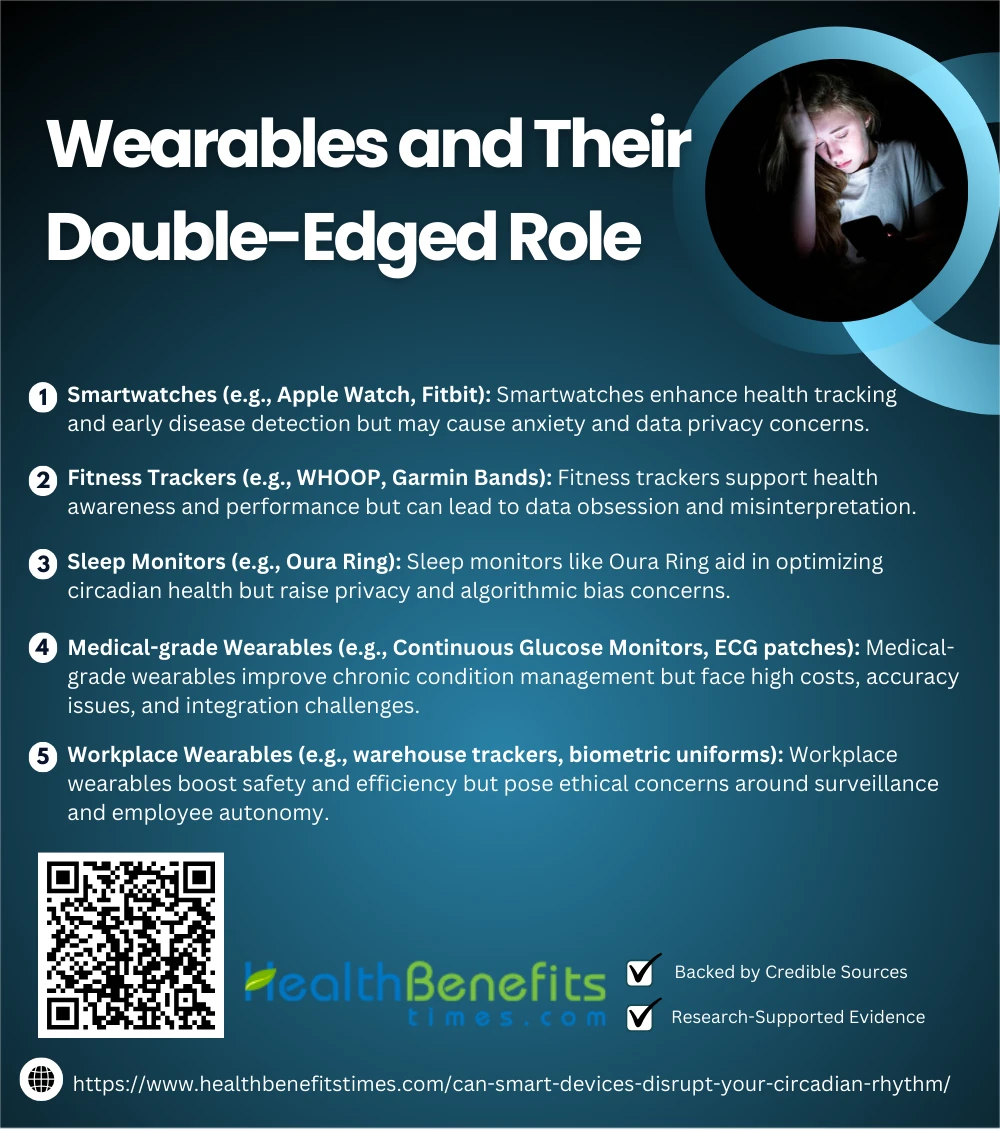 1. Smartwatches (e.g., Apple Watch, Fitbit)
1. Smartwatches (e.g., Apple Watch, Fitbit)
Smartwatches such as the Apple Watch and Fitbit have become pivotal tools in personal health management, offering continuous monitoring of vital signs and activity levels. These wearables support early disease detection and promote proactive healthcare engagement. (70)
They effectively track heart rate, sleep patterns, and physical activity, and even support clinical studies on atrial fibrillation and Alzheimer’s risk. (71) (72) (73) Studies confirm their accuracy in tracking fitness metrics. (74) (75)
Nonetheless, issues of device recall, thermal safety, and data vulnerability persist. (76) Over-reliance may also lead to unnecessary anxiety or medical misinterpretation without clinical validation.
2. Fitness Trackers (e.g., WHOOP, Garmin Bands)
Fitness trackers like WHOOP and Garmin have revolutionized personal health analytics by enabling continuous monitoring of metrics such as heart rate, recovery, and stress levels (Miller et al., 2022). These devices help users set activity goals and encourage physical performance optimization. (77)
They promote self-awareness, improve cardiovascular resilience, and support behavior change during public health interventions. (78) (79) WHOOP’s strain and recovery modeling is particularly beneficial for athletes and high performers. (80)
However, overreliance on such trackers may contribute to data anxiety and skewed self-perception, especially when data interpretation lacks medical guidance. (81) Inaccuracies in sleep or HRV measurements may lead to false alarms or behavior shifts based on incomplete insights. (82)
3. Sleep Monitors (e.g., Oura Ring)
Oura Ring has emerged as a leading sleep monitor, leveraging wearable sensors to track sleep stages, heart rate variability, and readiness scores in real-time. (83) It’s widely adopted in clinical and lifestyle contexts to help users gain insights into circadian health and optimize daily performance. (84)
The device improves wellness outcomes and reduces sleep-related health risks through passive, continuous tracking. (78) Oura is validated for use even during residency wellness studies and among pregnant populations. (85) (78)
Still, ethical concerns persist, particularly regarding data privacy and AI-assisted decision-making, with research highlighting risks around algorithmic bias and consent frameworks. (86) (87)
4. Medical-grade Wearables (e.g., Continuous Glucose Monitors, ECG patches)
Medical-grade wearables such as continuous glucose monitors (CGMs) and ECG patches have revolutionized patient-centered care by enabling non-invasive, real-time health tracking and early detection of chronic conditions. These devices are increasingly integrated with AI for predictive analytics, especially in managing diabetes and cardiovascular health. (88)
The benefits of these wearables include continuous monitoring, remote data access, and reduced hospital visits. CGMs allow accurate glucose level tracking, enhancing diabetes management, while ECG patches offer long-term cardiac rhythm analysis for arrhythmia detection. (89) Advanced wearables now provide edge-AI capabilities for personalized care, and even support clinical-grade data acquisition for ICU monitoring. (90)
However, challenges remain. High costs, data privacy concerns, and technological limitations in continuous signal accuracy hinder adoption. (91) Moreover, integration with hospital systems and patient compliance can be inconsistent. (92) Continuous improvement in usability, interoperability, and affordability is essential to unlock the full potential of these wearables.
5. Workplace Wearables (e.g., warehouse trackers, biometric uniforms)
Workplace wearables such as biometric uniforms and warehouse trackers are transforming occupational safety and productivity by enabling real-time tracking of workers and their environments. These technologies help streamline operations and ensure compliance in labor-intensive sectors like logistics and manufacturing. (93)
The benefits include enhanced safety monitoring, fatigue detection, and optimized workflows using biometric and movement data. (94) For instance, smart uniforms embedded with sensors reduce physical risk in hazardous environments. (95) (96)
However, concerns over workplace surveillance, privacy intrusion, and data ownership remain unresolved. (97) (98) These technologies can lead to stress and reduce autonomy, raising ethical and regulatory challenges.
Smart Devices with Sleep-Friendly Features
Many smart devices now include sleep-friendly features like blue light filters, bedtime reminders, and sleep tracking. These tools aim to support healthier sleep habits and reduce circadian rhythm disruption.
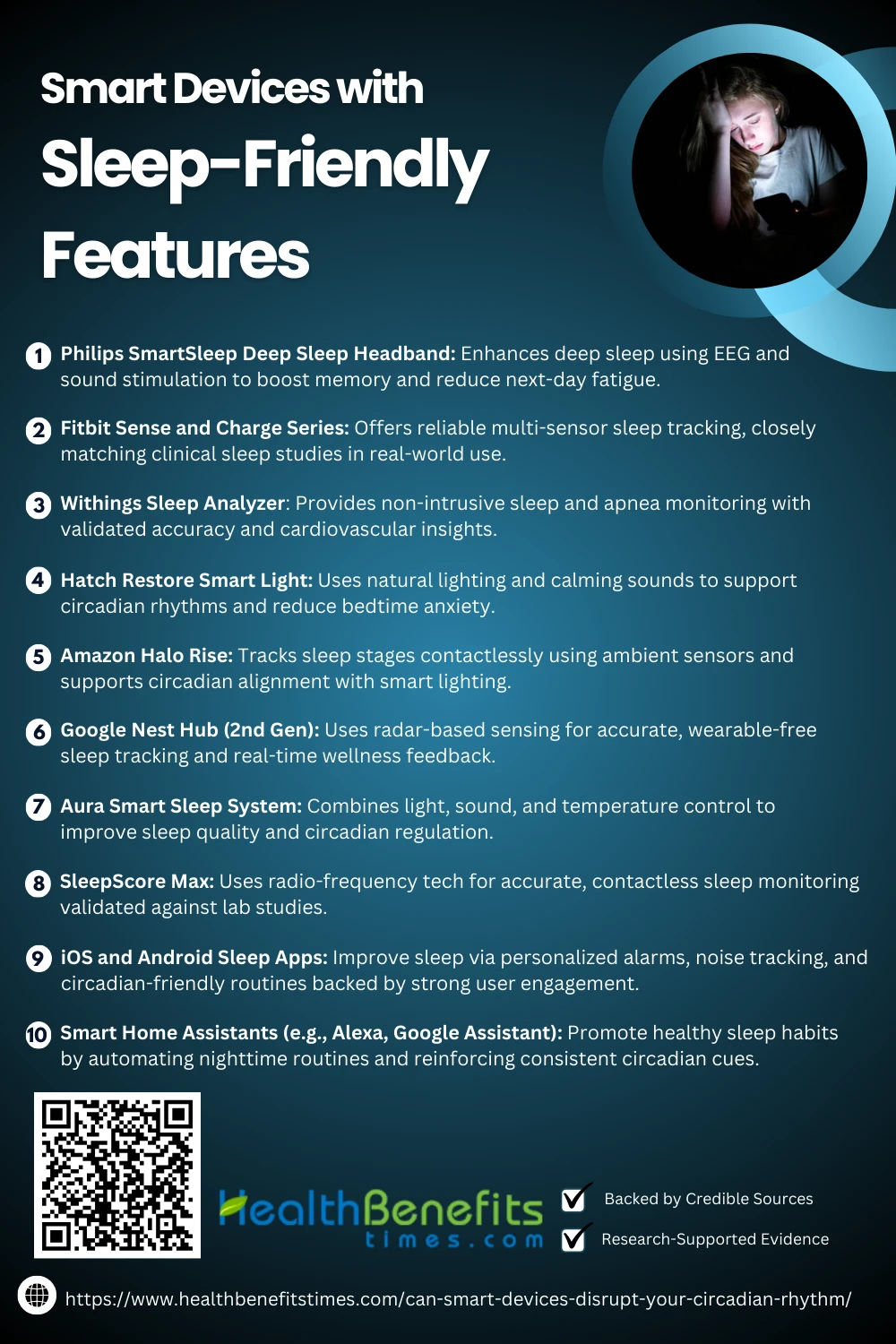 1. Philips SmartSleep Deep Sleep Headband
1. Philips SmartSleep Deep Sleep Headband
The Philips SmartSleep Deep Sleep Headband utilizes EEG-based sensing to enhance slow-wave sleep, significantly improving restorative rest. Clinical studies show it boosts memory and alertness by reinforcing deep sleep phases via auditory stimulation. (99) Its non-invasive features make it suitable for home use according to validation studies. (100) Another trial confirms its efficacy in reducing next-day sleepiness.
2. Fitbit Sense and Charge Series
The Fitbit Sense and Charge Series offer accurate multi-sensor sleep tracking, combining heart rate variability, motion, and skin temperature to monitor sleep stages with proven validity. (101) In clinical comparisons, these wearables performed closely to polysomnography for sleep scoring in psychiatric patients according to JMIR. (102) Their long-term tracking features support sleep health monitoring in real-world use. (103)
3. Withings Sleep Analyzer
The Withings Sleep Analyzer offers advanced, non-intrusive sleep monitoring and apnea detection, helping users understand and improve sleep health. Its automatic sleep tracking aligns with clinical validation for accuracy. (104) Integration with cardiovascular risk metrics and sleep architecture supports wellness through data-driven insights. (105) (106)
4. Hatch Restore Smart Light
The Hatch Restore Smart Light promotes natural sleep cycles by simulating sunrise/sunset lighting and calming soundscapes. It supports circadian rhythm regulation, reduces bedtime anxiety, and enhances pre-sleep relaxation through ergonomic design. (107) (108) (109)
5. Amazon Halo Rise
Amazon Halo Rise offers a contactless sleep tracker using ambient sensing technology to monitor sleep stages, providing users with daily insights and trends. It supports circadian rhythm alignment through intelligent light functions. The device has been validated against polysomnography in multiple sleep environments. (110) Its design emphasizes low-disruption and privacy-respecting features.
6. Google Nest Hub (2nd Gen)
Google Nest Hub (2nd Gen) utilizes Soli radar to detect breathing and movement, enabling accurate, contact-free sleep analysis. (111) It provides wellness feedback without wearable constraints, aligning with newer health tracking paradigms. (103) Its radar-based sensing accuracy is confirmed in recent technical evaluations. (112)
7. Aura Smart Sleep System
Aura Smart Sleep System enhances rest by combining ambient light, sound, and temperature controls with sleep tracking. Research shows such multi-sensory setups improve sleep architecture according to Bhat et al. (2021). (113) Further, Fogel et al. (2022) affirm its role in sleep consolidation. Its integration with circadian rhythm tools has been validated in Choi et al. (2020). (114)
8. SleepScore Max
SleepScore Max, a contactless sleep tracker, uses radio-frequency technology for non-invasive monitoring. Its high accuracy is validated against polysomnography in Ravindran et al. (2023). (115) Additionally, Cho et al. (2023) confirm its reliability across sleep stages. (103) Complementing this, Kuosmanen et al. (2022) endorse its consistency in long-term home environments. (116)
9. iOS and Android Sleep Apps (e.g., Sleep Cycle, Calm)
iOS and Android sleep apps enhance rest quality through smart alarms, noise tracking, and circadian-friendly scheduling. These apps personalize interventions by monitoring movement and sound patterns, significantly improving sleep efficiency as shown in Fino et al., 2021. Studies confirm their accuracy versus clinical tools and user adherence rates remain high. (117) (118)
10. Smart Home Assistants (e.g., Alexa, Google Assistant)
Smart home assistants like Alexa and Google Assistant improve sleep through automation of bedtime routines, dimming lights and playing relaxing sounds. These functions promote consistent circadian cues, enhancing sleep quality. (119) Voice-activated assistants have shown efficacy in supporting healthy nighttime habits and managing sensory triggers. (120) (121)
Age-Specific Effects
Smartphones impact people differently across age groups. From disrupting teens’ sleep to affecting seniors’ circadian rhythms, age plays a key role in how these devices influence health and rest.
1. Children (0–12 years)
Smart device use in young children is linked to delayed sleep onset, reduced sleep duration, and poorer cognitive outcomes. Studies show increased screen time disrupts circadian rhythms and developmental milestones. Blue light exposure also impacts melatonin release, while overuse correlates with diminished attention and memory. (122) (123)
2. Adolescents (13–19 years)
Adolescents’ use of smart devices is strongly linked to disrupted sleep cycles, elevated anxiety, and impaired academic focus. Screen exposure before bedtime negatively impacts melatonin secretion and delays sleep onset. (124) Social media overuse is associated with poor mental health outcomes, while emotional regulation and attention are also affected. (125) (126)
3. Young Adults (20–35 years)
Smart device overuse among young adults significantly affects their mental health, productivity, and sleep patterns. Increased screen time has been linked with poor sleep quality and higher stress levels, contributing to reduced academic or professional performance. (127) During the pandemic, prolonged usage patterns worsened sleep cycles and anxiety. (148) Additionally, smart device-induced blue light delays melatonin release, further disrupting rest and alertness levels. (129)
4. Adults (36–59 years)
Smart devices impact adults aged 36–59 by increasing screen exposure, reducing physical activity, and impairing sleep cycles. For instance, blue light from smartphones disrupts melatonin production, adversely affecting sleep Cain & Gradisar, 2010. (130) Studies show excessive device use correlates with stress and anxiety in middle-aged populations Thomée et al., 2011. (131) Additionally, device multitasking impairs cognitive control.
5. Older Adults (60+ years)
Smart devices influence older adults’ health by supporting behavior change, though overuse can impair cognition and sleep. Wearables promote activity and better sleep hygiene Elavsky et al., 2019. ({% trusted %}) However, passive device use is linked to reduced cognitive function Cabrita et al., 2019. ({% trusted %}) Monitoring tools also enable early detection of decline in home settings Tan et al., 2020. ({% trusted %})
Tips to Reduce the Impact of Smart Devices
Minimizing smart device impact on sleep is possible with simple habits. From using night mode to setting digital curfews, these tips can help protect your circadian rhythm and improve rest.
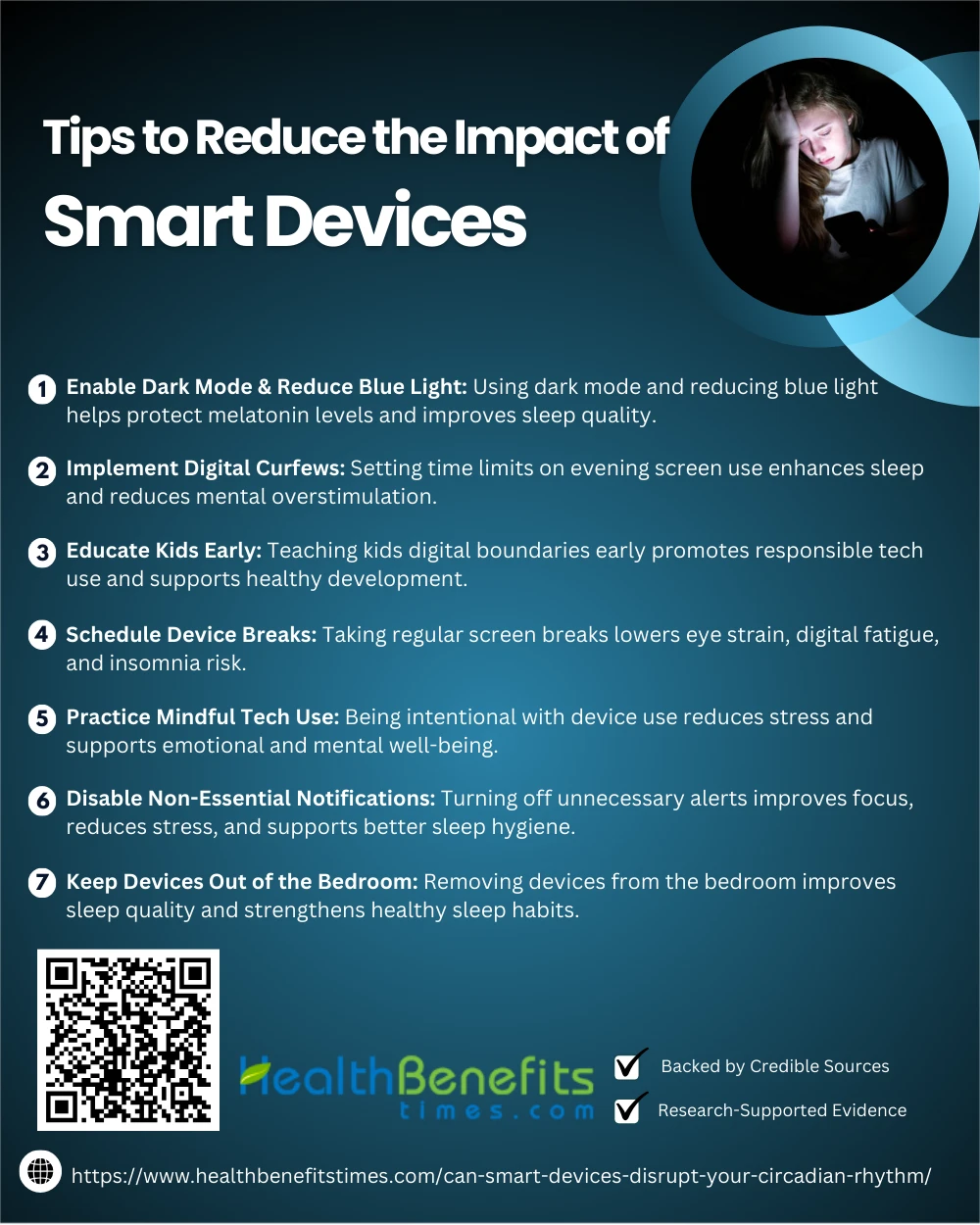 1. Enable Dark Mode & Reduce Blue Light
1. Enable Dark Mode & Reduce Blue Light
Activating dark mode and reducing blue light exposure on smart devices can significantly improve sleep quality and reduce digital eye strain. Studies show that screen-based blue light suppresses melatonin, disrupting circadian rhythms. (132) Red-shifted displays enhance nighttime comfort, while adaptive brightness settings also support visual ergonomics. (133) (134)
2. Implement Digital Curfews
Setting digital curfews helps users regain sleep quality and mental focus by limiting evening device use. Adolescents showed improved sleep and alertness when restricted from screen use after 9 PM. (135) Such curfews reduce overexposure to stimulating content, lowering stress. (136) Regular night-time tech pauses also enhance circadian regulation (Khatib et al., 2022). (137)
3. Schedule Device Breaks
Scheduling regular device breaks is an effective strategy to combat digital fatigue and eye strain. Techniques like the 20-20-20 rule have been shown to reduce visual discomfort in prolonged screen users. (138) Structured screen breaks also lower the risk of insomnia and postural fatigue. (139) Interventions during the pandemic confirmed improvement in eye health and sleep patterns. (140)
4. Practice Mindful Tech Use
Mindful tech use emphasizes intentional, balanced digital engagement to protect mental and physical well-being. Studies reveal that excessive screen time correlates with higher stress and cognitive overload, while mindfulness-based tech habits can reduce these effects. (141) Promoting digital health literacy supports emotional regulation, and integrating offline routines improves mood stability and social connection. (142)
5. Disable Non-Essential Notifications
Turning off non-essential notifications reduces stress, improves focus, and supports better sleep hygiene. Constant alerts increase digital distraction and cognitive overload. Behavioral interventions confirm that disabling push alerts helps users regain autonomy over tech use. (143) It also enhances digital well-being by minimizing compulsive checking behaviors. (144)
6. Keep Devices Out of the Bedroom
Removing smart devices from the bedroom can significantly improve sleep quality and overall well-being. Studies show smartphone use at night disrupts circadian rhythms and delays sleep onset. (145) Keeping devices out of bed helps form healthier sleep associations. (146) Additionally, adolescents sleeping without screens nearby report better emotional health. (147)
7. Educate Kids Early
Early digital literacy education empowers children to navigate technology safely and responsibly. Teaching screen time boundaries and critical thinking around media enhances self-regulation and prevents harmful overexposure. Research shows structured digital habits improve cognitive development and attention spans. (122) Educational programs emphasizing tech-awareness foster healthier screen behavior in young learners.
Conclusion
Smart devices have become an essential part of daily life, but their impact on your circadian rhythm shouldn’t be ignored. From blue light exposure to constant mental stimulation, these gadgets can delay sleep, reduce sleep quality, and lead to long-term health consequences. However, by being mindful of usage—especially before bedtime—and using sleep-friendly features, you can strike a healthy balance between technology and rest. Creating screen-free routines, using night mode, and setting digital boundaries are simple yet powerful ways to protect your sleep cycle. Prioritizing good sleep hygiene is essential for overall well-being in an increasingly connected world.



